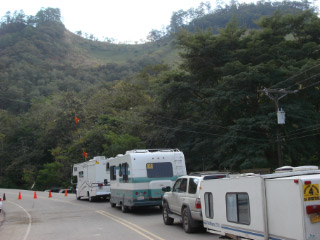
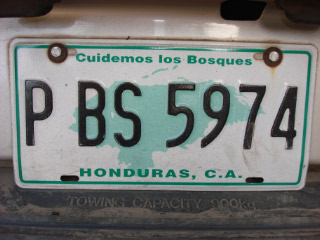
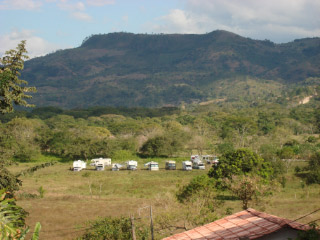
Chapter 5. Honduras



(Shari) Four down and eight to go. I am talking about border crossings. This morning, I awoke at 5:15 sick to my stomach. I have worked myself into a dither about this crossing. Never been this way, never did this crossing, the Panama group does not use this crossing so there is no road log, nor GPS tracks and I worry anyway. Bert says he has a guide for us. Well, he found him on the Internet, albeit he came recommended by other people he found on the Internet. What if he is not at the intersection? What if he never shows up?
(Bert) We double back, heading down the mountain, in the direction we came from yesterday. At a T-intersection we meet Jorge who has come to guide us on a road not previously used by caravans. The highway is in much better condition than we imagined and it winds through picturesque mountains toward Honduras. Border work progresses smoothly with Jorge’s guidance and our prepared spreadsheet paperwork and multiple photocopies of passports and titles. While we handle the half-dozen exit and entrance steps, the others rest in their rigs or visit the vendors – unsalted cashews being the popular purchase – or bird the border. Mark stops me to lend his binoculars for viewing a Plain Wren perched atop a short distant tree. I remember spending a half-hour in Belize last year unsuccessfully trying to coax a singing Plain Wren from its hiding place and now, here, it perches in plain view. Parakeets fly past too fast to identify, but we surmise they are Green or Orange-fronted. An owl roosting in a tree makes some wish for an exotic find, but it turns out to be the Ferruginous Pygmy-Owl we see most often.
(Shari) You can imagine my relief when I see a white Toyota Corolla parked in the middle of the street and a man jumping out hollering “Señor Frenz”. We quickly make our introductions and he leads us the few miles to the border. He tells us where to park and what to do. He leads us from one booth to another saying that it is easy and we don’t have to do anything about our cars, since Central America is freer now. I tell him about the other caravans and how they have to get their cars out of one country and into another and ask him to find out. I am right and he is wrong, so we retrieve everyone’s passports and SAT vehicle forms and start the process of stamping the vehicles out and stamping them in. We walk to one building and get directed to another. A young person in the office is very nice and accommodating and Jorge asks for two people to work on the process. Again our border information sheets are invaluable and the laborious manual processing only takes 10 min. per vehicle.
The whole border crossing only takes us 2-1/2 hr. and we arrive in Copán Ruinas well before lunch. My heart sinks as soon as I see the field where we are to park. It is loaded with dry prickly weeds up to my kneecaps. I tell Bert that the first thing we need is someone to mow this. The field itself meets my criteria of large, flat and safe but ….
(Bert) In good time we are finished with border procedures and are on our way to Copán Ruinas. Jorge directs us to a vacant field, entering through a narrow gate in the fence. The field is uncut, densely covered in knee-high brown grass. I wonder if we will get stuck and I wonder if we will find chiggers and other insects. Jorge assures me it is solid and has been used for fairgrounds. I plunge forward and park, then direct the others through the fence opening. Jorge and I now commence a litany of errands. I say we need the grass cut along side the entrance to each RV and walking paths connecting our vehicles to the road. Jorge asks two of his neighbors who soon appear with machetes and in a few hours we now have “streets” and “front yards” in our RV “park”.
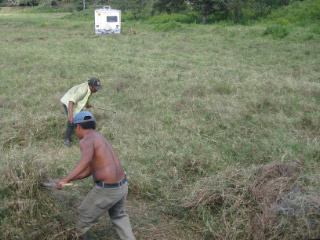 (Shari) Bert spends the next many hours collecting the books, toys, clothes
and medicines that we all brought for the bilingual school, orphanage and
clinic, arranges laundry pickup and delivery, looks at the pool and showers at
the hotel next door and takes a delivery tour of the town, orphanage and school
with Jorge. What do I do? I watch the two young men hack away at the weeds in
the field making a path from each rig to the road and a wider “patio” in front
of our rig. I think I have the easier of the two jobs and have lucked out. But
then I had the harder work at the border and he was seen birding with the group
while Arlene and I made payments and handled paperwork. I pay the two men for
their hard work and both they and I are grateful.
(Shari) Bert spends the next many hours collecting the books, toys, clothes
and medicines that we all brought for the bilingual school, orphanage and
clinic, arranges laundry pickup and delivery, looks at the pool and showers at
the hotel next door and takes a delivery tour of the town, orphanage and school
with Jorge. What do I do? I watch the two young men hack away at the weeds in
the field making a path from each rig to the road and a wider “patio” in front
of our rig. I think I have the easier of the two jobs and have lucked out. But
then I had the harder work at the border and he was seen birding with the group
while Arlene and I made payments and handled paperwork. I pay the two men for
their hard work and both they and I are grateful.
(Bert) Now out come the items our group has collected, purchased and carried from the U.S. as donations to the community. Kay and Dorothy join Jorge and me as we drive around town making deliveries. First we visit Mayatan bilingual school to deliver boxes and bags full of children’s books, teacher’s materials, pencils, sharpeners, colors, etc. Sarah, the director of the school, gives us a tour of the facilities. She is from England and many others are paid and volunteer teachers and helpers from the U.S. The school started in 1991 with 9 students in a shack near the Copán Maya site and now has grown to 300 students from pre-kindergarten to ninth grade at a campus of buildings on the edge of Copán Ruinas. The facilities and staff of the private school are impressive and all has been accomplished by donations, volunteers and tuition. Admission of students is spread among three groups: those that can afford full tuition, those that can pay part of it and those that are fully subsidized. The main focus is on providing a great education and getting students to be fully fluent in Spanish and English by graduation, recognizing that this preparation will be the path out of poverty.
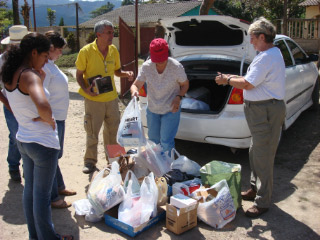
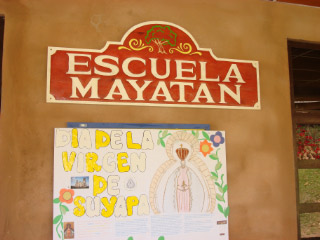
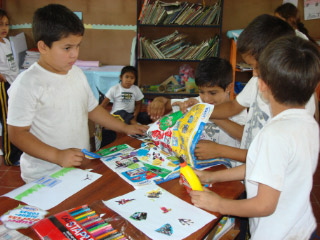
Our next stop is a medical clinic to deliver bags full of over-the-counter medicines and drugs we bought in the U.S., items that to them are very expensive and always in short supply in poor villages. Then we head to an orphanage, but before we get there Jorge shows us his house. A concrete and stucco building with high ceilings and tiled floors has spacious rooms – family room with large flat panel TV, dining room, kitchen with modern appliances, children’s room for his two boys who attend the bilingual school, Jorge’s bedroom and small office. Jorge appears to be in a middle class of professionals that live well, although not extravagantly. Quite a contrast is the tiny one-room, open-doorway buildings where many of his neighbors live. In fact, the two men hacking the grass with machetes live in two of these houses – if that is what you can call these structures – on the corner and the $15 each that we will pay them will be a significant addition to their meager income. Just down the street – another exaggerated word for a steep rock path that lacks any construction whatsoever – is the orphanage. This is the saddest, most depressing place on our tour. The dark hovel holds 23 niños and 22 niñas, age 18 mo. to 12 yr. – the most popular name is Maria, of which there are five – receives no government or church support and gets by on random community handouts. Orphanage is not quite the right word to use for this facility, since only some of the children spend the night here. For others it is a day-care center for young children of mothers who must work all day and have no support from the fathers. They pay nothing for the day-care, nor could they afford to pay. However good intentioned this is, no way would I want my grandchildren to spend even a few hours in this facility. When we bring in the toys we brought with us, they show some appreciation, but plead for food. Kay is especially saddened by what she sees and later with the help of Jorge she shops and pays for a $100 grocery list of food items that they deliver to the orphanage.
We make a few other stops – to the bank for money exchange, to a laundry to ask questions, and to a store to buy oversized garbage bags to collect our trash – and then drive back to our camping area to gather up all the bags of laundry from the group. We deliver a carload of bags which will be laundered by tomorrow afternoon at the price of 10 limpiras (about 53 cents) per pound. Our next task is to arrange for a 24-hour guard to watch our camping area. Although not a requirement, we want the extra security that an armed policeman offers us against curious visitors. Already we have had a half-dozen children visiting with bracelets to sell and an insatiable interest in us and our vehicles.
Finished with errands, I sit comfortably in the shade of the setting sun and notice my first birds of the afternoon: Violet-green Swallows and a Lesser Nighthawk.
(Shari) In late afternoon Bert and I walk the few blocks to the town. I get to see the hotel and pool, some nice restaurants, gift stores, and fresh produce market. We return and sit outside with a small group for a social before returning and actually making dinner at home using the generator to run the microwave to thaw and cook salmon, hot water for instant mashed potatoes and fresh broccoli.
(Bert) We start walking from our camping field at 6:30, headed to the Copán Maya site. It takes a long time to make the short distance because the flowering trees are loaded with colorful birds catching the morning sunlight. We see orioles and again begin the discussion on what exactly we are viewing. Jorge corrects our impressions and tells us they are Streak-backed Orioles, although Spotted and Altamira also occur here.
Atop one tree, darting in and out of the dense foliage is a mixture of euphonias: Scrub, Yellow-throated and the special prize of Elegant. In the next tree we find a Rufous-browed Peppershrike, the first for the trip. While a few of us chase after a better view of a parakeet I quickly pass over a grayish bird that I dismiss as a strangely postured mockingbird. A few minutes later, when I am marking my checklist I see Slate-colored Solitaire on the list and quickly look it up in my field guide and recognize it as the bird I saw.
Before we enter the ruins we walk the periphery, with dense woods on our left
and open pastures on our right. One collection of foraging warblers gives us
pause and Mark starts pishing to attract their attention. To our delight a wren
appears and we see brown back, rufous barred tail, white breast and bold white
supercilium of a wren curiously called Plain. At another warbler flock we find
Chestnut-capped Warbler, variously considered a subspecies of Rufous-capped or a
full species in its own right. This one stays low enough and in good light so I
can photograph it .
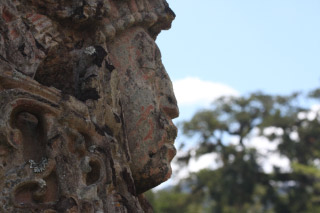
Now begins our tour of the ruins. I have visited over two dozen ancient Maya
cities, but the one I’ve been told to see most often is Copán. Now I am finally
here. What Copán lacks in terms of the size of Chichén Itza and Palenque, the
grand scale of Tikal and the strength of Caracol, it makes up for in the
exquisite condition of the elaborately formed three-dimensional stelae. On other
tours, the guides can only help us imagine what the city looked like and they
can vaguely point to outlines that mean something to archaeologists. Here, Jorge
is able to show us minute details on the tall stelae that fill in history,
rulers, dates and beliefs of a people that were at their apogee of artistic,
architectural, astronomic and mathematical abilities 1100 to 1200 years ago. The
ball court, a feature of every Maya city, is intact even to the point of showing
us the six heads of macaws – the sun imposter to Mayas - used as the
point-scoring goal markers, as well as a grander and larger macaw higher above
the field.
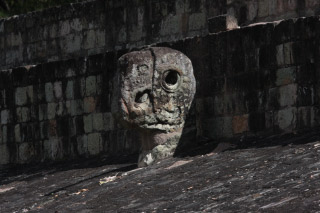 Another feature I had not realized from visits to other ruins is the
hieroglyphics carved into the faces of the steps on the grand staircases of the
temples and the use of large modeled figures resting at strategic points on the
staircase ascension. As Jorge is explaining the unusual ratio of men to women in
the graves of Mayas found below a gathering of middle class dwellings, a
Short-tailed Hawk swoops over our heads and we hear the frightened squawking of
a small bird clutched in the raptor’s talons.
Another feature I had not realized from visits to other ruins is the
hieroglyphics carved into the faces of the steps on the grand staircases of the
temples and the use of large modeled figures resting at strategic points on the
staircase ascension. As Jorge is explaining the unusual ratio of men to women in
the graves of Mayas found below a gathering of middle class dwellings, a
Short-tailed Hawk swoops over our heads and we hear the frightened squawking of
a small bird clutched in the raptor’s talons.
In the afternoon, some remain birding at Copán and five of us take one of the
enclosed scooter-like taxis to Macaw Mountain Bird Park and Nature Preserve.
Caged birds are not my usual interest, yet this place intrigues me because of
the good opportunity to see and photograph many of Honduras’s native parrots,
parakeets, macaws and Emerald Toucanet. I am especially fascinated by the Green Macaw, an
endangered bird I hope to see in the wild some day. We see few birds outside the
cages, yet one noteworthy sighting: a Strong-billed Woodcreeper with a
noticeably long thick bill. Wanting to leave earlier than the
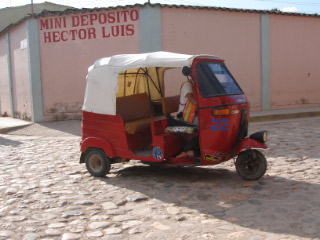 others so that I
can help retrieve the finished laundry, I alone take a scoter taxi back toward
camp. We only get partway down the mountain slope when two attractive young
ladies motion to the driver for a ride. In they climb, with the three of us
squeezed tightly in the narrow back seat. While Mexican and Guatemalan ladies
dress very conservatively and fully, I have noticed that Hondurans do not. Both
ladies – probably in their late teens – have deeply scooped necklines and one
reveals the sides of her torso in a tight-fitting scant blouse, an enticing
attraction to their male companions and also to old men, myself included. As we
bump through the rocky streets of Copán Ruinas, it is a challenge to keep my
eyes looking forward.
others so that I
can help retrieve the finished laundry, I alone take a scoter taxi back toward
camp. We only get partway down the mountain slope when two attractive young
ladies motion to the driver for a ride. In they climb, with the three of us
squeezed tightly in the narrow back seat. While Mexican and Guatemalan ladies
dress very conservatively and fully, I have noticed that Hondurans do not. Both
ladies – probably in their late teens – have deeply scooped necklines and one
reveals the sides of her torso in a tight-fitting scant blouse, an enticing
attraction to their male companions and also to old men, myself included. As we
bump through the rocky streets of Copán Ruinas, it is a challenge to keep my
eyes looking forward.
(Shari) I see the birders out the kitchen window when I get up. It is quite surreal, since they are all looking away from me with their binoculars pointed toward the mist on the horizon which is sandwiched between the ground and the mountain peaks. I have a leisurely cappuccino before I hear a knock on my door. Bob is standing with our guard and two other men. Bob tells me he does not understand what they want. I have them tell me and I don’t understand what they want either. I tell them to use other words and speak slowly. I still do not understand, especially when one of the men grabs his chest. I mimic his motion and he says “Si!”. I still do not get it. He grabs his shirt and repeats the words again. It looks like he wants something to do with my “boobs”. Well, I grab one of mine and they all nod yes. I look at Bob and he looks at me. I tell the men to write it down, ”Mamografias”. I tell Bob it looks like they want something to do with mammography. I look the word up in a dictionary and that is correct. Now it dawns on me. It seems the man’s mother needs a mammogram and they thought we were doctors and had X-ray equipment in our rigs. I tell them that we are not doctors and don’t give mamografias. That is both a funny story and a sad one. I wonder why the man was asking that for his mother.
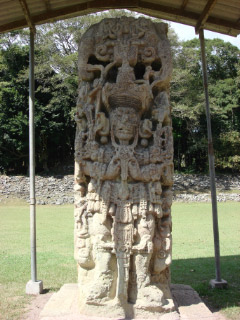 Bob and I then gather our stuff and head to the ruins. It is only about a
half-mile from here and the morning is still cool. I am met by Bert and the rest
of the group. I expected that I would have to walk around the ruins by myself
and I am pleasantly surprised that Jorge is going to give us a tour. He is an
entertaining and knowledgeable guide and tells us the history of the area. These
Mayas have a rather gory past and many carved stones remain where people were
sacrificed to the gods. Some even have indentations for their heads to be
severed and troughs for the blood to run down where it was collected, put on
paper, dried and burnt as an offering. Most of the men that competed in the ball
games were prisoners and then were sacrificed at game’s end. The stelae are
extremely well preserved and some even have remnants of their original colors. I
have seen pictures and the edifices are extremely colorful with bright reds and
blues. I am fascinated by the free-roaming Scarlet Macaws – the national bird of
Honduras – and the coatis. I snap a lot of pictures, trying to capture the feel
as well as the scene. Bert can do that with his artistic compositions and I just
try, never succeeding, but never giving up either. My sore leg tells me it has
had enough and Arlene and I walk back home to sit in the shade of the RV.
Bob and I then gather our stuff and head to the ruins. It is only about a
half-mile from here and the morning is still cool. I am met by Bert and the rest
of the group. I expected that I would have to walk around the ruins by myself
and I am pleasantly surprised that Jorge is going to give us a tour. He is an
entertaining and knowledgeable guide and tells us the history of the area. These
Mayas have a rather gory past and many carved stones remain where people were
sacrificed to the gods. Some even have indentations for their heads to be
severed and troughs for the blood to run down where it was collected, put on
paper, dried and burnt as an offering. Most of the men that competed in the ball
games were prisoners and then were sacrificed at game’s end. The stelae are
extremely well preserved and some even have remnants of their original colors. I
have seen pictures and the edifices are extremely colorful with bright reds and
blues. I am fascinated by the free-roaming Scarlet Macaws – the national bird of
Honduras – and the coatis. I snap a lot of pictures, trying to capture the feel
as well as the scene. Bert can do that with his artistic compositions and I just
try, never succeeding, but never giving up either. My sore leg tells me it has
had enough and Arlene and I walk back home to sit in the shade of the RV.
One of the little girls that hangs around the RV’s comes to talk with us. She has an English/Spanish dictionary and she and I trade learning. For someone only around 10 years old and self taught, she has a remarkable command of English. Just by the fact that she carries that dictionary around, shows how interested she is in learning it. I predict that she will succeed in life. Bert comes back and we share a tropical fruit, cheese and Spam salad. Later we join Joanie and Mark at a great restaurant in town. We get a meal for four and feast on beef, chorizo, chicken, and many other accompaniments, washed down with Salva Vida, a good-tasting Honduras beer. Neither Joanie nor I want to walk back to our rigs so we flag one of those red 3-wheeled taxis and cram the four of us in it. It is a hoot, lugging the engine up the hill and racing down. A little later Tom knocks on our door to tell us we are going to be entertained by fireworks for a wedding. Not 10 min. later we are treated to a great fireworks display ignited from the road not 100 ft. from our rigs. Many of the group goes outside, including me in my pajamas to watch the 10 min. show. Copán Ruinas sure knows how to treat its guests, but alas I know the show was not for us but for the bride and groom.
(Bert) A leisurely morning start is prefaced with the birders checking the farm lane across the road. Indigo and Painted buntings, Gray-crowned Yellowthroat and various seedeaters are prevalent, but one bird goes unidentified. Mark and Joanie puzzle over the bird while we caravan through the mountains. At a rest stop they enthusiastically tell me what they eventually resolved after paging through several field guides. Independently, at two different locations yesterday and today, they viewed Tricolored Munia, a species of Southeast Asia and an escaped cage bird that has become established in a few parts of at least three Central American countries, including Honduras.
Again the mountain road is manageable, with but three short sections of disrupted pavement, perhaps the result of landslides. The scenery is eye-catching, especially at the sharp mountain turns when I should be watching the road. After a gas station break – at what would have been our alternative camping site, and a poor alternative at that – we are on the main highway to San Pedro Sula. With all too frequent deep potholes, the highway is worse than the country road we just left. Fortunately it improves on the flat straightaway through the mountain valley as we reach the big city. Our camping area is a grassy and shaded spot behind a 4-star hotel. I have a delightful swim in the 25-meter pool, the water now warmer at the lower elevation.
(Shari) Can’t stop taking pictures! Bert even takes pictures while he drives. Our road today winds down off the mountain and every turn is a delight. At one point I see the caravan twisting on the road above us. Our log says our highest point is close to 3000 ft. and as we descend the pine trees are no longer evident. We stop for a break at the Texaco station in La Entrada and I think everyone agrees that they were happier to stay in Copán Ruinas. Arriving early at our hotel in San Pedro Sulu, we have time to enjoy the facilities. Some lunch on the buffet, some swim, some use the sports club to exercise, some do Internet, others just relax, and we all enjoy ourselves until our Super Bowl party at 5:17. I have rented a hotel room and at least 17 of us cram into it bringing snacks to share and a chair to sit on. I fall asleep during the 3rd quarter and decide to go back to R-Pup-Tent. Bert later tells me the game got more exciting in the 4th quarter and the Colts won.
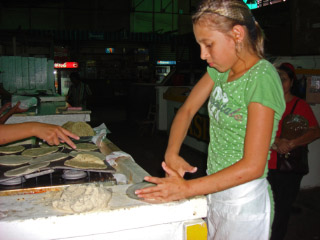
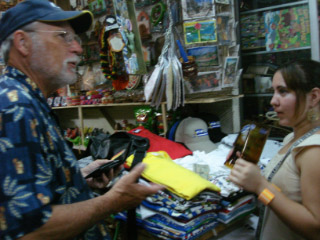
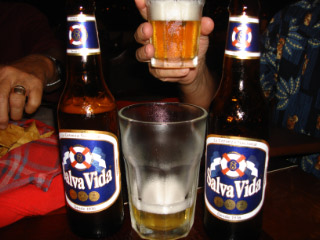
(Bert) A morning spent shopping is not on the top of my list of favorite things to do. Nonetheless, the marketplace is entertaining and the colorful display of local crafts is curious shopping. Most interesting to me is the dozens of women – including one 15-year-old girl – that are making tortillas by hand. All of them are fast and some are super fast in grabbing a fistful of corn dough, compressing it into an egg-shaped mass, pressing it once with a flat tool as they move the tool forward and thus create a nicely rounded flat surface. Then they knead the pancake with fingers, giving it a slightly dimpled surface, and throw it on the hot griddle where the raised bumps brown darker than the lower surface. The fast ladies can make three tortillas a minute and soon have high stacks of tortillas ready for selling. Back at camp, I spend the afternoon writing journals, making bird sighting entries and answering e-mails – tasks that have accumulated as birding took precedence.
(Shari) It seems my large group of people that signed up to go to the market turned into a small group. Chris and May wanted to rent a car and go to some birding spot and the group mushroomed and soon there are two cars going. I guess when weighing the two choices, more wanted to bird than shop. Oh, well, their loss! I know Bert would rather bird too, but he is swamped with details that he has to take care of and needs this free day. He does go along with our small group of six to the artisan market. The hotel courtesy van drops us off at 9:30 and is to pick us up at noon. We walk the aisles, reminiscent of border towns in Mexico but with different stuff. We notice two of the aisles are dedicated to the making of tortillas. There must be 40 stalls with two women each working over griddles. A big batch of dough has already been mixed and one woman takes a small piece, puts it on waxed paper, stamps it with a board, just once into a round shape, punches it with finger prints and slaps it on the hot griddle. A second woman turns the tortillas over and when done stacks them up on the side. Hundreds, no thousands of tortillas are made here to be consumed I no not know by whom. We watch a young girl who looks no older than my 10-year-old granddaughter, making the tortillas. We ask to take her picture and then ask her age. She says she is 15 and must be working with her mother. I wonder if that is all the life she has to look forward to. A surprising number of vendors know English very well. Bert and I purchase some presents for family, a dress for me, and fresh produce. Pat purchases the most and even has to buy a bigger bag so she can carry all her loot back to her rig.
We take a break at a small “food court” and Bert and I order burritas. We expected an egg, bean and cheese burrito but get scrambled eggs, refried beans, tortillas and a hunk of bland cheese. Oh well, we can wrap the food ourselves. One of the older vendors has taken a liking to Bert and has even followed him across the street to the food court. We talk a bit with her and Ralph tells her that I am his wife. She likes to touch his shirt and put her arm on his shoulder. She tells me he is “guapo” and those of us who know that means “handsome” just roar with laughter. Bert’s ears turn red. I am not too worried about her taking a fancy to him since I could not see that she had anything to sell that he would want, if you get my drift. I spend the afternoon receiving and writing e-mails, paying bills on line, correcting road logs, and writing this journal. Later we join a group of ten for dinner on the top floor, open air, steak restaurant of the hotel. Sharing a meal for five that could have served seven, we all request para llevar (doggie bag) and will have another meal at home with it. We got soup, salad, chips and bean dip, chorizo, steak, pork chop and chicken plus 5 beers for about $25 for two of us.
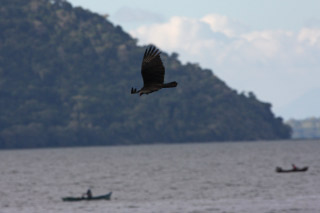
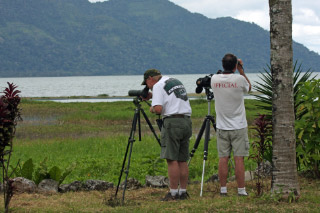
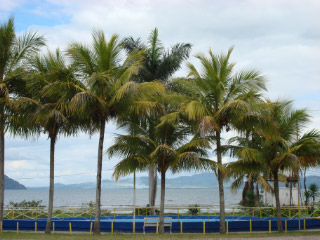
(Bert) One of the necessities of RV camping is a sewer dump, rarely a problem in countries with regular campsites, but one requiring strategic planning in countries that do not. Before we leave San Pedro Sula we line up our RV’s on a side street and one-by-one dump our black water tanks in an opened manhole to the city’s sewer system. We take care of other errands, such as refilling propane tanks (with butane), and then we are on a divided highway, four wide lanes with a central walled median, a superhighway.
In no time we have climbed the mountains again and are at the largest lake in
Honduras: Lago de Yojoa. Our camping place at a hotel beside the lake becomes an
instant success as the birders immediately set up scopes, lawn chairs and start
ticking off birds, including eight heron species, Lesser Yellow-headed Vultures,
omnipresent Snail Kites, gallinules and coots and several duck species which are
usually in short supply on our south-of-the-border trips. The floral gardens
attract Spot-breasted and Baltimore orioles and Common Tody-Flycatcher. Best of
all though is the unseen birds calling from the marsh. We puzzle over the short
bursts of staccato peeps emanating from undercover, not certain even to family
or whether it really is a bird and not insect or amphibian. I even record the
calls and play them back, but attract no attention from the caller. Chris solves
the problem with a check of his field guide when he identifies them as
Gray-breasted Crakes.
(Shari) Yesterday Bob walked around a city block to determine the best method to dump into a manhole in the street. The best laid plans of mice and men go awry when he repeats the route with his 36-ft. motor home. No sooner has he made the right turn out the gate, he radios back that the traffic is too heavy to make a turn. I think maybe we should wait for rush hour to pass. I walk outside and turn left and what should I see but Bob at the corner. I think, why not turn left here? And that is what we do, all dumping pretty fast and soon are on our way in three groups.
Our first group stops for propane and I have a great time practicing Spanish. At first I tell the man at the gate what I want. He points me to another area and I get the gist that motor homes can drive right up but fixed tanks go in a different gate. Then a few men come out and talk so fast Bert asks me to translate. I don’t get it either and no matter how many times I tell them to slow down, they do not. I get the word hot (they touch the hood of our car). I think maybe they are afraid of a fire and ask them how long we have to wait and they say 10 min. Then a man comes up with a fire extinguisher and they fill our tank. I ask where I pay and I am directed to another building about one block away. I go there and a man tells another man how many gallons I got. He writes it down on a piece of paper and gives it to me and asks me to write my name which he puts in a log book. He then points to the next office. I take it to the next office where I pay the man and then he says I have to take it back to the first office. I take the paper back to the first office, where the first man writes something in a log book and gives me the paper. I am done and everyone has a smile. I am so proud of myself since all this was done in Spanish. I am amazed every time I say something and someone understands. I think that people are just so friendly until we become the victims of a scam (we think).
Needing gas, we pull into a gas station and Bert says “Lleno”. He always says that and he has always been understood. Soon he is asking for my help to figure out what this attendant is talking about. I go out and the attendant keeps asking how many gallons or how much money we have to spend. How should I know? Finally, Bert gets out a 500 lempira bill and I say this much. The young attendant punches something into the pump and starts filling. Another man comes up and I ask him how to tell the attendant that we want a full tank. He says “lleno”. Isn’t this what we started with? He tells the attendant “lleno” and the attendant zeros the tank and then fills it. At the end, Bert thinks we only got 100 lempiras worth the first time and not the 500 we asked for. That is about $20 we may or may not have lost. We warned others of this scam and we became a victim of it. I let down my guard at the station since I had found everyone so nice at the butane plant.
When we arrive at our campground, everyone just loves it. On the shores of Lago Yojoa birds abound; it reminds me of our first trip to Mexico where we parked at Culiacan. Scopes are up, binoculars are strapped on and birders are out the door before all are parked. There are three places I see lawn chairs: on the shore of the lake, on the bank of the inlet and near the boat ramp overlooking the swamp. After I do a load of wash, wring it out, and hang it up, I make lunch and sit outside to eat it, enjoying the cool breeze. Soon a small middle-aged man starts to talk with me. I ask him to slow down and talk only one word at a time. He talks fast. I tell him I do not understand. He does not come any closer than my wash line and sits on the ground so he does not have to look between the socks to talk. We go back and forth, neither one of us understanding what the other is saying. I ask him to write it down. He writes his name and something else that I can’t read but when I repeat it after him, he says “Si”. I try to type that word in my translator to no avail. I finally hear the word “tortillas” and say “Quire unas tortillas?” He says “Si”. I go into the freezer and find the four tortillas that we brought back from a restaurant and hand him the bag. He grabs it and off he goes. How sad! I should have given him the chicken and steak too. Clay later tells me that he thinks Bert and I have some sort of sex appeal to attract these people. At 5:30 we gather our chairs on the shore and listen to Bert talk about hummingbirds. I know he knows birds, but I am still amazed at how many facts about the birds he retains and how interesting his talks are. He is guapa and intelligiente. Later we meet on the veranda overlooking the lake for a potluck. Seems between birding, everyone had time to whip up a tasty meal.
(Shari) Bert leaves at 6 AM and I turn over to fall back asleep not opening my eyes again until 8. Camp is very quiet with everyone gone. I can just piddle, enjoy the quiet, the lake view and cool air with my cappuccino and cinnamon bun from Finca Ixobel. I do a morning’s worth of paperwork and just sit down to read my great book (My Sister’s Keeper) when the birders come home. I hear all the stories before they go out again on their second trip with Jorge. Tonight we have a LEO and most of us meet on the veranda for another great meal. Bert has garlic fish and I get my favorite: whole fried fish with rice and beans cooked in coconut milk and fried plantains.
(Bert) Our Toyota Coaster bus picks us up promptly at 6 AM, just as the
attendant unlocks the gates that surround the hotel complex. We drive part way
around the north end of Lago de Yojoa to Agua Azul (elevation 2023 ft.), another
shoreline hotel where Jorge has often found Spotted Rail and Tricolored Munia in
the past. We see or hear none, except perhaps a brief view of a small dark bird
that Mike sees. A fly-by Muscovy Duck directly overhead is a nice addition
though. Now we head east of the lake, traveling up and down the mountains for a
half hour, reaching 2394 ft. before stopping at the headquarters for Cerro Azul
Meambar. With 20 birders today, we have about 15 ideas on how to spend the day
birding. Since I haven’t been here before, Jorge gives us the layout of the
trails. Scattered plans start converging and we finally settle on several: 1.
Mike hikes the longest, most rigorous trail at a fast pace, with limited
interest in the birds and, instead, seeing the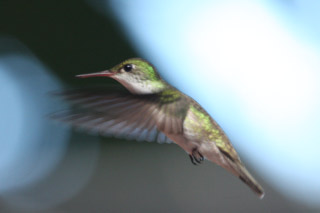 expansive views of the mountains
and Lago de Yojoa. 2. Chris, Tom and Charlu take the same difficult uphill trail
at a slower pace and have the good fortune of finding a Keel-billed Motmot at
close view and Chris returns with excellent photos of the life bird he has often
sought. 3. Ralph and Dorothy start the rigorous trail, but soon turn back and
explore the forest and shaded headquarters area at a slower pace. 4. Most of us
take the lower and shorter trail through the dense forest. 5. Judy follows her
usual pattern of finding a few quiet places to sit and wait for the birds to
come to her. 6. May stays near the headquarters and is the only one to find
Chestnut-capped Brush-Finch and Green Jay.
expansive views of the mountains
and Lago de Yojoa. 2. Chris, Tom and Charlu take the same difficult uphill trail
at a slower pace and have the good fortune of finding a Keel-billed Motmot at
close view and Chris returns with excellent photos of the life bird he has often
sought. 3. Ralph and Dorothy start the rigorous trail, but soon turn back and
explore the forest and shaded headquarters area at a slower pace. 4. Most of us
take the lower and shorter trail through the dense forest. 5. Judy follows her
usual pattern of finding a few quiet places to sit and wait for the birds to
come to her. 6. May stays near the headquarters and is the only one to find
Chestnut-capped Brush-Finch and Green Jay.
For all of us entering the highland forest, we hear a few birds and see
almost none. While the habitat is excellent, luck is not with us today and even
the few birds that make a close approach – Common Bush-Tanagers, Azure-crowned
Hummingbird, Stripe-throated Hermits – are nearly impossible to see in the dense
foliage. A tall and plunging waterfall deeply imbedded in the forest is a
refreshing break from hiking and we make a closer approach by traversing a
swinging bridge, one person at a time. We reach headquarters by 10 AM, stop for
a Golden-hooded Tanager and spend
the next few hours in the shade, sitting on stools and benches, watching the
active hummingbird feeders and the flowering trees above. The entertaining and
relaxing show includes White-bellied Emeralds, Rufous-tailed Hummingbirds,
Long-billed Hermit and Violet Sabrewing at the feeders, and Plain-capped
Starthroats, Buff-throated Saltators and a half-dozen others at the trees. The
best bird, a lifer for most everyone, is one so brightly colored it seems ironic
that it is so difficult to locate in the tree. The lemon yellow and brilliant
green of the Blue-crowned Chlorophonia somehow blends well with sunlit green
leaves.
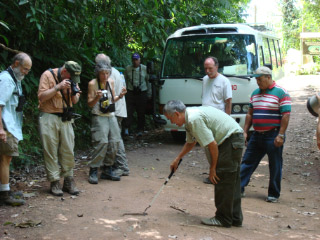
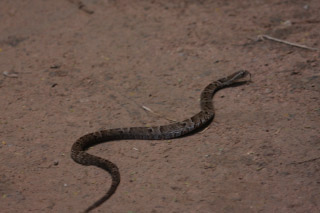
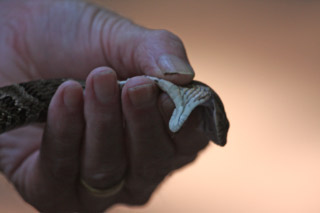 Just as we leave the headquarters area in our bus, Jorge orders driver Carlos
to stop and he jumps out to distract something in the road. I see he has a snake
by the tail and we pile out to see it closer. Carlos brings a snake hook and now
Jorge plays with the snake, keeping it in the center of the gravel road so we
can examine it. Jorge says it is a False Fer-de-lance, not poisonous, so John
picks it up and grabs it just behind the head so we can examine its mouth and
see its rear fangs.
Just as we leave the headquarters area in our bus, Jorge orders driver Carlos
to stop and he jumps out to distract something in the road. I see he has a snake
by the tail and we pile out to see it closer. Carlos brings a snake hook and now
Jorge plays with the snake, keeping it in the center of the gravel road so we
can examine it. Jorge says it is a False Fer-de-lance, not poisonous, so John
picks it up and grabs it just behind the head so we can examine its mouth and
see its rear fangs.
We stop in the village for groceries, most purchasing milk in small bags, bread and drinks. After an hour’s break at the camping site, half the group continues on the bus around part of the lake to a country road where we can walk and see the marsh. Flocks of Fulvous Whistling-Ducks feed at the lake’s edge to the marsh and in more weedy areas are a profusion of herons, gallinules, jacanas and Snail Kites.
On the tree-lined pasture side of the road I find a Crimson-collared Tanager lurking in the shadows. Two separated groups announce birds at the same time and those caught between the groups have to choose between Yellow-breasted Chat and Tropical Parula. I go for the parula. Large flocks of Chestnut-headed Oropendolas, totally hundreds of birds, fly overhead, perhaps headed to roosts.
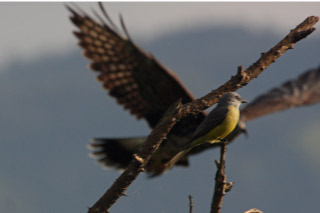
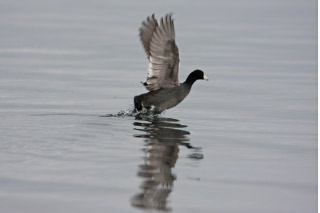
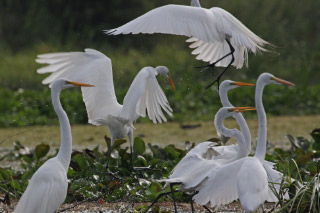
(Bert) Thousands of herons and ducks enthrall us for an hour. Riding in a fishing boat propelled by a 15-hp outboard, Mark, Joanie, Chris and I search the shoreline marshes of Ojo de Agua for Rufescent Tiger-Heron and rare rails. We find two Bare-throated Tiger-Herons and no Rufescent, although our boat driver says he has seen the rarer one on the lake. Mostly we are seeing the same species we tallied from shore the past two days, but the perspective is different and the numbers greater. I don’t think I’ve ever seen as many Purple Gallinules in a day, much less an hour. We add only a few species we hadn’t seen here before: Black-necked Stilt, Spotted Sandpiper, Belted Kingfisher. When we return to shore the four of us each pay the boat operator. Later the owner of the hotel chases down Shari and asks for payment of the boat. We tell her we have already paid and a confusing Spanish-English exchange ensues that finally boils down to the facts that we paid the driver not the owner of the boat, the driver received an enormous tip, and we still owed for the boat ride.
(Shari) Bert joins three others in a boat around the lake to find more birds. Meanwhile others bird the property and I read. We are just about ready to leave, when a man asks about paying for the boat. Bert says that they paid the boat driver which I explain to the man. Soon the owner of the hotel comes down and asks for the boat payment. I explain to her that they paid the driver and she explains to me that that was considered a tip. Bert is quite adamant about not paying more. Mark says that the owner should ask the driver for the money. I do not want to burn bridges, so I pay the owner and consider it a lesson learned. Find out who to pay before paying. We travel about 23 mi. before stopping. Clay wants a Wendy’s hamburger for lunch. So here we are in Honduras eating at the nicest biggest cleanest Wendy’s I have ever seen. The guard at the bank even helps us park in the lot. Group Two comes in about the time we are leaving.
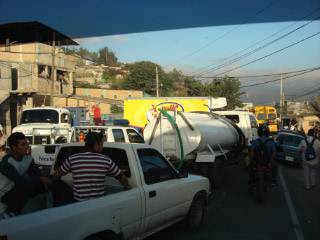 We travel through mountains, climbing up seven miles, then down, climbing up
twelve miles then down, climbing up again, then down. Some of the road has a
passing lane and sometimes it does not. Bert starts to drive like a Honduran and
passes on a curve or a hill or in town or whenever he can make it past the slow
trucks. I would have enjoyed the ride more if he would have taken it easier.
Arlene told us last night about the horrible drivers in the town of Tegucigalpa.
We arrive there at 1:30 and find the drive to be a breeze. The road is two to
three lanes on each side of the boulevard with no stop signs, no topes and no
potholes. We sail through it and arrive at our Esso station by 2:45. It takes
another hour for the next two groups to arrive and we hear a horror story about
how a truck pulled out in front of one of our people and did a lot of damage to
their rig in Tegucigalpa. Sadly the town lived up to its reputation. Fortunately
no one was hurt and the rig is drivable but the incident does put a damper on
the group. The truck driver lost his mirror and never stopped to even apologize.
Bert has a bird count and I try to conduct a travel meeting. Both of us are
interrupted by hundreds of Scissor-tailed Flycatchers landing in nearby trees to
roost and a bat that John catches in order to get a closer look. We then
actually eat a salad in the rig for a change.
We travel through mountains, climbing up seven miles, then down, climbing up
twelve miles then down, climbing up again, then down. Some of the road has a
passing lane and sometimes it does not. Bert starts to drive like a Honduran and
passes on a curve or a hill or in town or whenever he can make it past the slow
trucks. I would have enjoyed the ride more if he would have taken it easier.
Arlene told us last night about the horrible drivers in the town of Tegucigalpa.
We arrive there at 1:30 and find the drive to be a breeze. The road is two to
three lanes on each side of the boulevard with no stop signs, no topes and no
potholes. We sail through it and arrive at our Esso station by 2:45. It takes
another hour for the next two groups to arrive and we hear a horror story about
how a truck pulled out in front of one of our people and did a lot of damage to
their rig in Tegucigalpa. Sadly the town lived up to its reputation. Fortunately
no one was hurt and the rig is drivable but the incident does put a damper on
the group. The truck driver lost his mirror and never stopped to even apologize.
Bert has a bird count and I try to conduct a travel meeting. Both of us are
interrupted by hundreds of Scissor-tailed Flycatchers landing in nearby trees to
roost and a bat that John catches in order to get a closer look. We then
actually eat a salad in the rig for a change.
(Bert) Again today, our drive through Honduras is on good roads, although winding up and down through the mountains slows our pace. Our elevation repeatedly rises and falls between 3000 and 5000 ft., offering expansive views of the mountains. We follow signs to Tegucigalpa and then propel through the huge city on a 4-6-lane boulevard at 40 mph without stop signs. I wonder what the population is, as we see thousands of closely spaced homes built across the valley and up against the mountain slopes. [Later I find out the population is 700,000]. On the opposite side of the city we again climb into the mountains, but this time the road is either two-lane or three-lane. The center lane is meant as a climbing lane and is yellow-lined to deter downhill drivers from occupying it. Undeterred, Hondurans race down the lane and around sharp curves, unmindful of slow uphill drivers coming straight toward them. Swerving in and out is commonplace and dangerous. Although not keeping pace with the racers, Judy and I have smaller vehicles with good acceleration and we have little trouble passing the slow trucks on the uphill. With larger RV’s, it takes Lee and Clay a bit longer to find enough straightaway to get past crawling traffic. We arrive at the gas station that will be our camping site and do not hear from the other two groups for over an hour. We hear later that the larger rigs had a much harder time of it and, in fact, one got cut off by a truck and was side-swiped, causing extensive damage to the RV.
At 5 PM, I conduct a bird count-off for Lago de Yojoa, reaching an impressive
list of 122 species at the lake. The count is frequently interrupted by flocks
of Scissor-tailed Flycatchers all flying in the same direction. I wonder if the
scissor-taileds are heading to a roost site as they do in Texas during
protracted fall migration. Shari’s travel meeting is also interrupted when Mark
spots a bat struggling under a hedge row. Tom and John attempt to capture it and
I race into R-Pup-Tent to retrieve my leather gloves. Using the gloves, John
picks up the bat and we examine it. Biologist John has studied bats and with the
aid of my mammal field guide he deduces it is a Black Mastiff Bat before he
releases it.
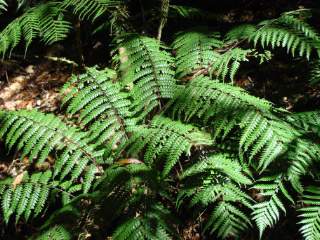
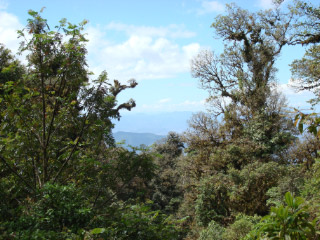
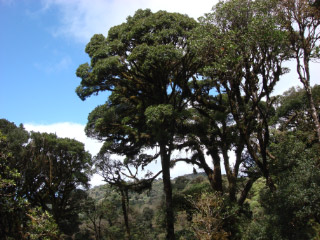
(Bert) Our bus driver Santa Cruz arrives a bit before our scheduled 6 AM departure, but guide Roberto is not with him. He speaks only Spanish and when I quiz him about Roberto he seems puzzled. He calls Jorge and hands his cell phone to me. Jorge explains that Roberto’s house was broken into yesterday and Roberto must go to the police today, so he cannot be our guide. Santa Cruz knows the way to La Tigra, so off we go. First we must again pass through Tegucigalpa, the congested capital of Honduras. Santa Cruz knows how to handle the bus and is soon weaving in and out of traffic until we come to almost a complete standstill at a narrow section with vendors on one side, dilapidated buildings on the other and people milling like scurrying ants around us. The two-lane highway is now four lanes of weaving vehicles. In a few minutes we come to the obstruction, a large truck positioned broadside across both lanes with traffic trying to wedge along the road edges to pass. On the opposite side we see a small pickup smashed headfirst into big truck. A police car arrives with lights flashing, but goes around as we do and continues into the city. Traffic now flows quickly as we head to Tegucigalpa Centro and then turn on a steep narrow road that winds up the mountainside, past a continuous maze of housing units, most of them absent of street-side windows and fenced on the street side with 12-ft. high block walls. At what must be the better houses, the walls are crowned with coiled barbed wire. We continue climbing for miles, the apartments and homes getting better at high altitude, and then getting poorer again as we eventually reach the outskirts of the city. Still climbing, we enter pine-forested mountains. At 6300 ft. we reach La Tigra National Park, a delightfully serene contrast to the congestion we just left.
In Spanish, Kay talks to the headquarters attendant and with the aid of a
small map we work out a strategy of which trails to hike. Again, some wander off
on their own, but most of us hike Sendero La Esperanza, eventually climbing 800
ft. to 7110 ft. elevation. We are barely started on the trail when we come to
flowering bushes that attract Amethyst-throated and Wine-throated hummingbirds.
The Wine-throated puts on a display for us, coming to rest on an open branch and
flashing its iridescent pink gorget in the morning sunlight, fanning it out like
a handlebar mustache or bowtie, then alighting quickly and helicoptering in
front of red flowers it taps for nectar.
In the dense and tall forest, the air is cool and some even put on a light jacket. A soft breeze whistles through the canopy and the groomed hiking path starts out easy. Birds are far and few between, yet each one is a delight as most are ones we have not seen or heard before. We find woodcreepers and struggle for clear views through the interweaving leaves and branches, eventually deducing we have seen both resident species: Spotted and Spot-crowned woodcreepers. Two enchanting singers we hear repeatedly are Slate-colored Solitaire – which reminds me of Varied Thrush in song – and Ruddy-capped Nightingale-Thrush – which sings a symphony in minor key like Hermit Thrush. We never see any of the solitaires (although Chris later reports that he found one) and some in our group see a Nightingale-Thrush prowling through the leaf litter.
Four bonking calls in four seconds signal a Mountain Trogon, not on our expected list, although unmistakably identical to our recordings. We try for 20 min. to get a look at the trogon calling from high in the canopy and eventually at some distance from where I am standing, Lee, Mark and Tom find the bird, although distantly. Another new bird for us is a Rufous-browed Wren which entertains us when we stop to rest on some benches. The wren is much prettier than Ber Van Perlo’s drawing and more closely resembles the darker bird in Sophia Webb’s drawing.
Kay is the first to see a large bird flying through the forest. A few of us find the bird and excitedly announce Resplendent Quetzal. Everyone now asks for directions and I use my green laser pointer to mark the trees and leaves leading toward the perched bird. It changes perches and is less visible, but still recognizable as a young male with a shortened tail. Clay does not get a good view and is not sure he will count this a life bird. Fortunately, an hour later I hear another one calling and Lee finds it in the dense foliage. Clay will count this one. The whole body is visible and I hear later that it is joined by another and they perform courtship acts.
We are late in our rendezvous at headquarters, the hike becoming more
strenuous uphill and then downhill again along what was once a forest road that
now has slipped down the mountainside and can barely handle a bicycle. At the
headquarters I finally get a good look at a flock of Bushy-crested Jays. On the
bus ride back to Ojo de Agua, Chris shows me a photograph of a Golden-cheeked
Warbler that he found while hiking La Tigra. Although wintering in Honduras, I
doubt many locations are known and perhaps La Tigra is a new one to science.
Later when I scan through mine own photos I find one of a Golden-cheeked Warbler
also .
(Shari) Five AM, Bert gets up and I think I may not fall back asleep, but I do and don’t wake again until 6:30. The birders are gone, leaving Ralph, Dorothy, Arlene and me to guard camp. I take my ease at waking up, drinking coffee, eating breakfast and making the bed before I tackle receipts, log book and some details for our Alaska trip. I need to use the Internet so walk to the restaurant to ask about our bill and the use of their Internet computers. The young lady wants to charge me twice as much as I expect so I tell her I will return later after I get the contract, explaining in Spanish and she understands. I return with the contract and she agrees with my version of the charges. After paying my bill, asking and receiving a receipt, I ask to use the Internet. She sets me up but I cannot find the “@” key. You cannot send an e-mail without that character. I find that I have to press the “Alt”,”6” and “4” keys all at the same time. I cannot find EarthLink. Finally I find a past reference to it in the history bar (probably Bert’s use yesterday) but the dumb site will not accept my password. I don’t know how to tell the girl that I forgot my password so say, “No se mi palabra de securidad.” (I don’t know my word of security.) I only bring that example up because I find I have a larger vocabulary and can put different words together to make my meaning understood. Back to the rig, I find Bert’s cheat sheet, which I take back to the restaurant. I am wearing out quite a bit of shoe leather by now, walking back and forth. I don’t think I do anything different but I get onto the EarthLink site and retrieve and send my e-mails even printing an Alaska Ferry schedule and writing to them about a planned trip to Kodiak Island. I visit with Arlene and Bob about tomorrow’s border crossing, return to R-Pup-Tent, eat lunch and decide to defrost the freezer. At 1 PM I start to empty the two shelves with stuff still from the United States. I stretch the curly cord (not so curly anymore) of my bathroom hairdryer as far as it will go, turning it on to the hot setting. Twenty-five minutes later the inch plus thick layer of ice lies in a puddle on the freezer floor to be wiped up with a Turkish towel. I finished the task from start to finish in 30 min. I spend the rest of the afternoon reading another good book, Jane Austen in Boca, before the birders return. I find out they had a great time and saw a quetzal, my favorite bird of all time. I say that the trip is over now and we are returning home and I see some sad faces until they realize I am joking. Bert and I try out the restaurant next door and have tasty chicken, fish, fries, cheese, juice, beer, ice cream and tortillas for a total of $11.00.